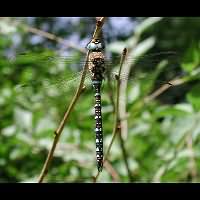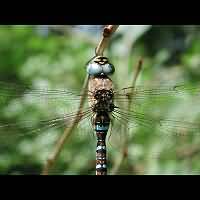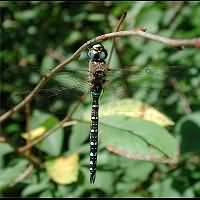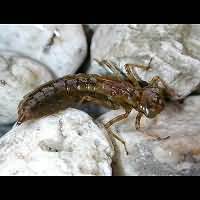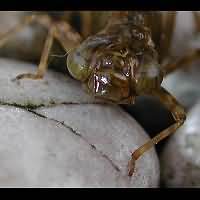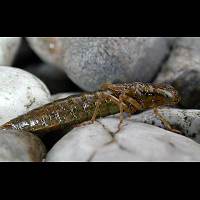[All pictures of garden wildlife on this page are thumbnails. Click on any thumbnail for a large format to be displayed.]
Migrant Hawker (Aeshna mixta)
The Migrant Hawker is a rather big Dragonfly. Adult males have a brown thorax. A few yellowish lines run over it. The abdomen is brownish black with lots of small blue rings. It is very similar to the male of the Green Hawker. The sides of the thorax of the latter however are green, not brown. It is also similar to the Southern Migrant Hawker, but that is not a British species (last seen in 1952 in Kent). The female of the Migrant Hawker is easily identified by the brown abdomen with small yellow and black smears and rings. The Migrant Hawker will reach a length of 63 mm and the wingspan may be up to 85 mm.
The female Migrant Hawker prefers to lay her eggs on floating objects like drift wood. Depositing the eggs takes place late in summer or even the beginning of autumn. The eggs don't hatch immediately, but overwinter first. Next spring the young appear. Like the larvae of most Dragonflies, they are very greedy and grow fast. Still they don't become adult in the same year, but usually overwinter once more. Only in the southern regions of Europe the cycle may be completed in just one year. This species isn't picky at all and usually is found in smaller ditches and ponds, including those in gardens! By the way, it is not certain the bottom pictures really show the Migrant Hawker's larva. The larvae of the hawkers are very similar indeed, so this may be the larva of another species.
The Migrant Hawker is an excellent flyer, often appearing far away from water. It is regularly seen in gardens and parks. It is keen on hunting at the edges of woodlands and around bigger bushes. The males often have a territory in which females are readily allowed, but other males aren't tolerated. Sometimes Migrant Hawkers hunt in big mixed groups, especially over grasslands. It is often difficult to photograph as it flies well and often. Yet it is worth keeping an eye on them, for once settled in a resting place it is not easily scared away and may become a very good model indeed. The Migrant Hawker is common in most of England, especially the south, and parts of Ireland.
The female Migrant Hawker prefers to lay her eggs on floating objects like drift wood. Depositing the eggs takes place late in summer or even the beginning of autumn. The eggs don't hatch immediately, but overwinter first. Next spring the young appear. Like the larvae of most Dragonflies, they are very greedy and grow fast. Still they don't become adult in the same year, but usually overwinter once more. Only in the southern regions of Europe the cycle may be completed in just one year. This species isn't picky at all and usually is found in smaller ditches and ponds, including those in gardens! By the way, it is not certain the bottom pictures really show the Migrant Hawker's larva. The larvae of the hawkers are very similar indeed, so this may be the larva of another species.
The Migrant Hawker is an excellent flyer, often appearing far away from water. It is regularly seen in gardens and parks. It is keen on hunting at the edges of woodlands and around bigger bushes. The males often have a territory in which females are readily allowed, but other males aren't tolerated. Sometimes Migrant Hawkers hunt in big mixed groups, especially over grasslands. It is often difficult to photograph as it flies well and often. Yet it is worth keeping an eye on them, for once settled in a resting place it is not easily scared away and may become a very good model indeed. The Migrant Hawker is common in most of England, especially the south, and parts of Ireland.

© Copyright 1998-2024 gardensafari.net (Hania Berdys)

 English / engels
English / engels  Dutch / nederlands
Dutch / nederlands